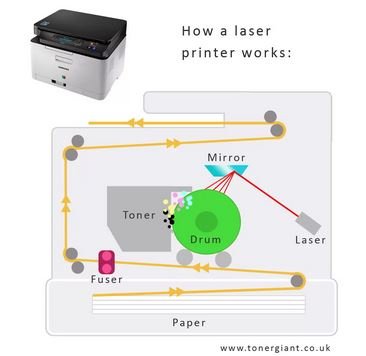So I stumbled upon this while studying for a troubleshooting test and it was fascinating to me. I've always wondered why laser printers are called that, and because the printouts always come out hot, I assumed the lasers were maybe shone directly on it. But what about the toners/ ink? If the lasers did the work, why are they needed? Is some magic involved?
Well, not magic, but it turns out some scientific concepts you wouldn't expect are! Such as static electricity, mirrors, and opposing electrical polarities. Here's a quick description.
So, turns out laser printers are made up of the laser diodes, a large metal 'drum', the toners (ink), and a fuser unit. When a print is initiated, the motors which run everything take a sheet of paper from the tray and begin to pass it up a belt. Meanwhile, the lasers are beamed off of mirrors to heat up the now-rotating drum, essentially writing the info to be printed on it and infusing it with static electricity. Those areas written upon get a positive charge, which attracts tiny amounts of ink from the toner. As the paper (which has a negative charge) passes, the drum rolls over it, imprinting it with the ink and transferring the info onto it.
However, these amounts of ink are small and are mainly in particle form. That's where the fuser comes in. The paper passes between the fuser 'pads', which are extremely hot and use heat and pressure to permanently infuse the ink particles onto the sheet. This process is what makes the printout sheets hot, and not the lasers themselves!
Once this is done, our printing is complete and the printout rolls out into the exit tray.
C'est finis!
Cool, huh?
This series is based on my personal experiences. If you have something to share, or an impression to correct, please do so! It's all about learning. Cheers!
LIKE || COMMENT || RESTEEM
Follow me @petermarie
